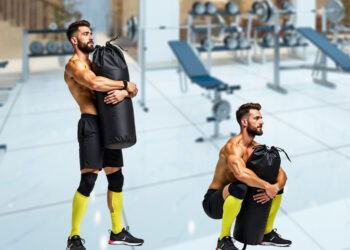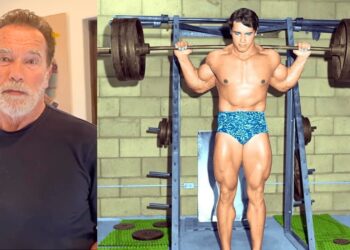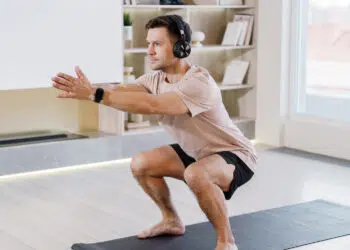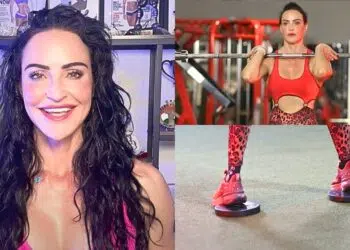I’ve been training for over 30 years. During that time, especially as I’ve gotten older, I’ve come to realize that warming up is one of the most crucial parts of any workout. A thorough warm-up prepares your muscles, joints, and nervous system for what you’re about to do (1). It also helps you get “your head in the game,” focusing your mind on the task ahead.
Consequently, I spend as much effort planning my client’s warm-ups as I do their actual training session. I owe it to them to ensure they get the most from every workout we do. After all, a good workout starts with a great warm-up!
There are many ways to get warm, but whatever you do should match the demands of what follows. In other words, you should tailor your warm-up to whether you are doing cardio, strength training, working your upper body, or training your legs. This is not the time for a one-size-fits-all approach.
The gorilla squat is one of my go-to warm-up exercises for leg day. It’s especially useful when barbell squats or deadlifts are on the agenda. In this article, I explain how and why to do gorilla squats and share some tried-and-tested tips and alternatives.
Gorilla Squat Correct Form
When it comes to exercise safety and effectiveness, form really matters. Correct exercise form minimizes the risk of injury while making the most of your time and energy. However, if you use sloppy form, you could hurt yourself, and the exercise won’t be as productive.
To that end, make sure you follow these step-by-step instructions whenever you do gorilla squats.
Level Up Your Fitness: Join our 💪 strong community in Fitness Volt Newsletter. Get daily inspiration, expert-backed workouts, nutrition tips, the latest in strength sports, and the support you need to reach your goals. Subscribe for free!
- Stand with your feet shoulder-width apart, toes turned slightly out. Pull your shoulders back and down, and brace your core.
- Soften your knees slightly, hinge forward from the hips, and bend over to grab your toes. Your arms should be straight.
- Bend your legs and use your arms to pull yourself down into a deep squat. Push your knees apart with your elbows and lift your chest. Hold this position for 2-3 seconds.
- Next, while keeping hold of your toes, extend your legs and push your hips up until your knees are almost straight. Pause in this position for 2-3 seconds.
- Bend your legs, lower your hips, and repeat.
Gorilla squat: Muscles Worked
The gorilla squat is a compound lower-body exercise. This means it involves multiple muscles and joints working together. The main muscles affected by gorilla squats are:
- Hamstrings
- Gluteus maximus
- Quadriceps
- Gastrocnemius and soleus
- Adductors
- Erector spinae
- Trapezius and rhomboids
Please note that while these muscles generate force during this exercise, gorilla squats are a lower body mobilizer and not a leg builder or strengthener.
Pro-Trainer Tips
Get more from gorilla squats with these tried-and-tested pro-trainer tips!
- Use a slow, controlled tempo. Stretching your muscles too quickly will trigger the stretch-shortening reflex, making your muscles tighten up rather than relax. Slow and steady is the way to go with this exercise.
- Increase your range of motion over the course of your set. Expect your first few reps of gorilla squats to feel a little awkward and clunky. However, as you warm up, you should be able to take your muscles and joints through a wider range of motion, and the movement should feel smoother.
- Pause for longer at the bottom and top of each rep if necessary. Do your hips feel tight? Spend a few extra seconds at the bottom of each rep to open your hips. Are your hammies feeling like overwound banjo strings? Stay in the top position for a little longer. Modify the exercise according to how your body is feeling.
- Adapt the exercise according to your flexibility. Don’t force yourself into a deep squat if you find it uncomfortable. Likewise, don’t try to straighten your legs if it hurts your hamstrings. Use the largest range of motion you can, but do not force yourself into unnatural positions.
Gorilla Squat Mistakes to Avoid
Make gorilla squats as safe as possible by avoiding these common mistakes.
- Going too fast. I often see people doing gorilla squats ballistically. In other words, they drop like a stone and then bounce straight back up again. This negates the benefits of the exercise and increases the risk of injury.
- Too much lower back rounding. While it’s normal to have some lower back rounding during gorilla squats, it should not be excessive. Reduce your range of motion or grip your ankles instead of your toes if your lower back bends excessively.
- Doing too many reps. The gorilla squat is not a conditioning exercise. Instead, it’s a dynamic mobilizer and stretch for your lower body. As such, you should avoid doing so many reps that your legs start to feel tired. If your quads are burning, you’ve done too much.
Gorilla Squat Benefits
Not sure if gorilla squats deserve a place in your workouts? Consider these benefits and then decide.
No equipment required
Gorilla squats are a bodyweight exercise. As such, you don’t need any equipment to do them. So, as well as being ideal for gym-based training, you can use gorilla squats to prepare for bodyweight or calisthenics workouts. Go for a walk or jog, do some air squats, lateral lunges, and gorilla squats, and you’ll be good to go!
Suitable for all fitness levels
Gorilla squats are a straightforward exercise that’s pretty easy to learn. Consequently, it’s suitable for all fitness levels. However, make sure you adjust your range of motion according to your flexibility and mobility. Don’t worry, for example, if you cannot straighten your legs at the top of each rep. Never force the movement, as that could lead to injuries.
The perfect warm-up for lower-body workouts
While general activities like bike riding and jogging raise your core temperature, they aren’t the best way to warm up for strength training. To prepare your muscles and joints for lifting, your warm-up should mirror the movements you plan to do during your workout.
With that in mind, it’s easy to see how the gorilla squat can help prepare you for squats, deadlifts, leg presses, etc. Like the best compound leg exercises, they involve simultaneous ankle, knee, and hip flexion/extension and use all of your lower body muscles. Gorilla squats also mobilize your spine.
Doing gorilla squats before your leg workout will enhance subsequent exercise performance, making your training session more effective. They could also lower your risk of injury.
Level Up Your Fitness: Join our 💪 strong community in Fitness Volt Newsletter. Get daily inspiration, expert-backed workouts, nutrition tips, the latest in strength sports, and the support you need to reach your goals. Subscribe for free!
A good way to break up long periods of sitting
Prolonged sitting is part and parcel of many people’s lives. However, while it’s something that many of us do for hours each day, too much sitting can hurt lower body mobility and flexibility. This can be a real problem as you transition from work to working out.
Gorilla squats stretch all the muscles that tend to tighten up due to prolonged sitting. It also mobilizes the joints most prone to stiffness, i.e., the hips, knees, and spine. If your hips and hamstrings are restricted and tight, daily sets of gorilla squats could be the perfect solution.
Gorilla Squat Programming
Gorilla squats work best as part of a warm-up. However, you can also do them anytime you want to mobilize and stretch your lower body and back, e.g., after a long drive.
This is not a conditioning or strengthening exercise, so you should not use them as such. Instead, keep your reps relatively low and focus on holding the top and bottom positions of each rep for several seconds. Sets of 6-10 are ideal for most people. You can do just one set, or if you are feeling tight, you could do 2 to 3 to maximize your mobility and flexibility.
Because gorilla squats are not a strengthening exercise, they won’t tire you out or cause muscle damage. Consequently, you can do them daily or even several times a day if you wish.
Gorilla Squat Alternatives
Gorilla squats are an effective way to stretch and mobilize your lower body. However, they’re not the only option available. Use these exercises as an alternative to gorilla squats or as an addition to your mobility and flexibility training.
1. Jefferson curls
The Jefferson curl is a weighted stretch for your hamstrings. It also mobilizes your spine. This exercise is ideal for experienced lifters looking to take their flexibility to new heights. In addition, Jefferson curls build strength in a stretched/flexed position. Fans of this exercise also believe that it can help alleviate and prevent lower back pain.
2. Asian squat
The Asian squat is the mid-point of the gorilla squat. With this exercise, you descend into a deep squat and then stay there, often for several minutes. This provides a deep stretch for your glutes, quadriceps, hamstrings, calves, and hip adductors. Asian squats are an excellent exercise for anyone who struggles to get into a low squat. However, they can also aggravate existing knee issues.
3. Forward bend
The standing forward bend is a yoga exercise or asana designed to unlock your hamstrings and mobilize your spine. From this perspective, it’s similar to the hip hinge/knee-extension phase of gorilla squats. Tight hammies make it harder to get into the starting position of gorilla squats and may lead to excessive lower back rounding. This exercise is an excellent solution.
Gorilla Squat Closing Thoughts
The gorilla squat is one of the best ways to warm up for a lower-body workout. It stretches your hamstrings, adductors, glutes, calves, and quads while mobilizing your ankles, hips, and knees. A few reps of gorilla squats will set you up for a great training session.
In addition, gorilla squats are an effective way to alleviate the tightness that often accompanies periods of prolonged sitting. I’ve done a couple of sets while writing this article!
However, make sure you modify your range of motion according to your flexibility and never force your muscles or joints into unnatural or uncomfortable positions. Also, remember to move slowly and deliberately; there is no need to rush.
Finally, understand that gorilla squats are just one of the ways you can mobilize and stretch your lower body. While they are a big hit with me and my clients, other movements may suit you better. Experiment to see which exercises you prefer.
References:
- Fradkin AJ, Zazryn TR, Smoliga JM. Effects of warming-up on physical performance: a systematic review with meta-analysis. J Strength Cond Res. 2010 Jan;24(1):140-8. doi: 10.1519/JSC.0b013e3181c643a0. PMID: 19996770.
Featured Image via @CROSSLIFTRTRAINING on YouTube!








